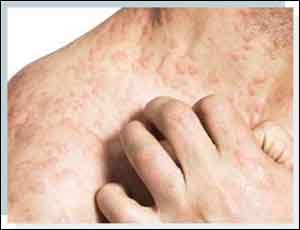- Home
- Editorial
- News
- Practice Guidelines
- Anesthesiology Guidelines
- Cancer Guidelines
- Cardiac Sciences Guidelines
- Critical Care Guidelines
- Dentistry Guidelines
- Dermatology Guidelines
- Diabetes and Endo Guidelines
- Diagnostics Guidelines
- ENT Guidelines
- Featured Practice Guidelines
- Gastroenterology Guidelines
- Geriatrics Guidelines
- Medicine Guidelines
- Nephrology Guidelines
- Neurosciences Guidelines
- Obs and Gynae Guidelines
- Ophthalmology Guidelines
- Orthopaedics Guidelines
- Paediatrics Guidelines
- Psychiatry Guidelines
- Pulmonology Guidelines
- Radiology Guidelines
- Surgery Guidelines
- Urology Guidelines
Atopic eczema: One size does not fit all

Researchers from the UK and Netherlands have identified five distinct subgroups of eczema, a finding that helps explain how the condition can affect people at different stages of their lives.
Doctors and patients have long known that the itchy skin condition can affect people in many different ways. Now Professor Sara Brown from the University of Dundee and collaborators at the University of Bristol and the University of Groningen, Netherlands, have shown for the first time that there are atopic dermatitis subgroups in children.
Professor Brown said: "This research study has confirmed that eczema is a very diverse disease, and it's provided evidence of distinctly different trajectories, including a group that hadn't previously been recognized, in whom eczema develops for the first time around six years of age and is often associated with asthma.
"We've also shown that genetic risk factors contribute to the most troublesome and long-lasting eczema, so these patients can be our focus for future research to improve care. It's also important evidence that we need to consider which subtypes of eczema may respond to which treatments in clinical trials to ensure the right children get the right treatment in future."
The researchers looked at 13,500 children from birth to 11 or 16 years, born in the UK or Netherlands. Around 40 percent of children developed eczema at some time in their life. Through statistical analysis, the researchers were able to identify different groups including children whose eczema begins in infancy but then resolves, as different from children whose eczema starts later or becomes a long-term problem.
The groups were defined as:
- Eczema starts in infancy and doesn't go away
- Eczema starts in infancy and lasts throughout childhood
- Eczema starts in infancy and goes away in early childhood
- Eczema starts in mid-childhood (around 6 years) and goes away later in childhood
- Eczema starts in late childhood (11 years-early teens) and then goes away
The largest group, approximately one-third of children with eczema, develop the disease soon after birth and mostly grow out of it by their fifth birthday. However, for the one in eight children with eczema who are in a group where eczema does not resolve, the disease can last into adulthood. These children are also most likely to have relatives with eczema and experience other health problems, including asthma and allergies.
Dr Lavinia Paternoster, Senior Lecturer in Genetic Epidemiology from Bristol Medical School: Population Health Sciences, who initiated the study, said: "This study brought together two European birth cohorts, PIAMA, from the Netherlands and ALSPAC (or 'Children of the 90s') from Bristol.
"The patterns of disease observed in these two cohorts were remarkably similar, which gives us greater confidence in the results.
"We've found some evidence of what might cause children to suffer from different subtypes of eczema, but we still need to do a lot more work to understand this further and work out how we can use this information in the clinic to better help patients."
Mrs. Magali Redding, CEO of Eczema Outreach Scotland, added: "This is a fantastic step forward for research on eczema in children. Families are desperate for clues about their specific circumstances and hope for the future.
"To families of children suffering from eczema, research results like this paper on sub-groups of patients provide much-needed hope for a clearer prognosis and ultimately better treatments.
"The impact of atopic dermatitis on people's quality of life can be devastating. With this chronic condition on the increase, the work of Professor Sara Brown and her academic colleagues is crucial and always welcome to our members."
For more details click on the link: Lavinia Paternoster, Olga E.M. Savenije, Jon Heron, David M. Evans, Judith M. Vonk, Bert Brunekreef, Alet H. Wijga, A. John Henderson, Gerard H. Koppelman, Sara J. Brown. Identification of atopic dermatitis subgroups in children from two longitudinal birth cohorts. Journal of Allergy and Clinical Immunology, 2017; DOI: 10.1016/j.jaci.2017.09.044

Disclaimer: This site is primarily intended for healthcare professionals. Any content/information on this website does not replace the advice of medical and/or health professionals and should not be construed as medical/diagnostic advice/endorsement or prescription. Use of this site is subject to our terms of use, privacy policy, advertisement policy. © 2020 Minerva Medical Treatment Pvt Ltd